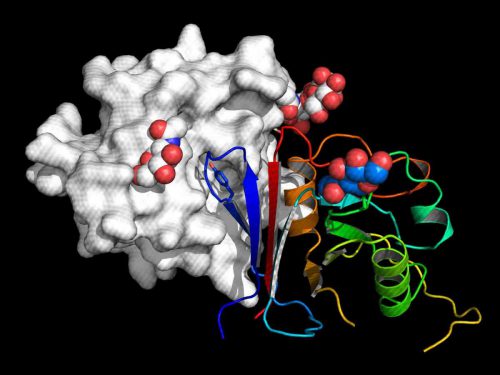The company "Yade", an arm of the commercialization of the intellectual property of the Weizmann Institute of Science, which promotes industrial and medical applications based on the inventions of the institute's scientists, registered a patent for the method, and is currently examining possibilities for the development of Arnsept as a medical treatment for humans

Some of the deadliest viruses that can be passed from animals to humans belong to the "arenavirus" family. Two of the viruses, called Junín and Machupo, previously infected humans in South America who came into contact with infected rodents. Like Ebola, these viruses can cause a hemorrhagic fever that leads to rapid death, and the only treatments available for these diseases are dangerous, complex, and only partially effective. Recently, Weizmann Institute of Science scientists and their research partners engineered a molecule that neutralizes the Honin and Chupo viruses, and even other viruses from the same family, and thus may be a cure for those viruses. Their findings are published these days in the scientific journal Nature Communications.
How do arenaviruses manage to cross the lines and move from rodents or other animals to humans? In a previous study in the laboratory of Dr. Ron Diskin from the Department of Structural Biology at the Institute, the researchers compared viruses that were able to pass to humans and other viruses from the same family that do not infect humans. The researchers discovered that the viruses that do not endanger humans, carry proteins that are not suitable for binding to the receptor that serves as a viral entry point into human cells. However, surprisingly, even in the dangerous viruses, the proteins do not perfectly fit the human receptor; And yet, their partial adaptation alone is enough for them to get inside.
The partial adaptation gave birth to the idea of developing a decoy molecule: to use receptors from the rodent cells that fit like a "glove" to the viral "entry proteins" in order to lure and capture the viruses and keep them away from the human cells. "Previous attempts to develop 'sticky' traps of this kind - that is, molecules designed to attract viral proteins - were based on human receptors," explains Dr. Diskin. "The fact that these receptors were the same as the receptors they were supposed to compete with, prevented them from presenting real competition." On the other hand, a molecule based on a rodent receptor, the researchers hypothesized, may be a significant competition to the human receptors.
To put this to the test, Dr. Hadas Cohen-Dabashi from Dr. Diskin's research group removed the end of the receptor from rodents in a "surgical" operation, mounted it on an antibody - and created a new molecule that was named "Erncept". The group began to subject this molecule to various tests; First, against "pseudo-viruses" - engineered virus-likes that carry the viral entry proteins, but do not pose a danger. Already at this stage, while collaborating with the research group of Dr. Vared Fedler-Karavani from Tel Aviv University, the researchers saw that not only did the Arnacept molecule bind tightly to the simulated viruses, it also mobilized the immune system to attack against the viral invasion.
The next stages of research were conducted in laboratories at the University of Texas, Galveston, in the United States and at the Pasteur Institute, Lyon, in France, where it is possible to conduct experiments with dangerous pathogens at the highest levels of safety. It was in these laboratories that Arnspet first faced attacks by the Honin and Chupo viruses. Also in these experiments, the researchers saw that Arncept binds strongly to the viruses before they are sufficient to bind to the human receptors and an activation of the immune response was also observed.
Since Arnacept is based on an entry point common to all viruses in the Arena family, and not on unique characteristics of each virus (as is the case, for example, with vaccines or antibodies), it is effective against all viruses in this family that pass from animals to humans and use the same receptor for this purpose. "It may even be effective against viruses from the same family that have not yet been discovered," says Dr. Diskin. What's more, all the signs indicate that Arnsept is non-toxic and even resistant to high temperatures, so that it can be sent to the warm regions where these diseases pose a danger. The scientists also believe that it may be possible to apply the idea of creating honey traps from mammalian receptors in a variety of other diseases that are transmitted to humans from animals.
The "Yade" company, an arm of the intellectual property commercialization of the Weizmann Institute of Science, which promotes industrial and medical applications based on the inventions of the institute's scientists, has registered a patent for the method, and is currently examining possibilities for the development of Arnsept as a medical treatment for humans.
Dr. Aliza Bornstein-Katz from the Weizmann Institute of Science also participated in the study; Dr. Ron Amon from Tel Aviv University; Crystal Agnes, Robert Cross and Prof. Thomas Geisbert from the University of Texas, and Dr. Mathieu Matteo and Prof. Sylvain Bayes from the Pasteur Institute.

2 תגובות
Why Arnfest?
Wow, the work done here sounds amazing!
The question is, is it already safe for use on humans?
When now parts of China are in isolation due to a viral disease that was transmitted from snakes (coronavirus).